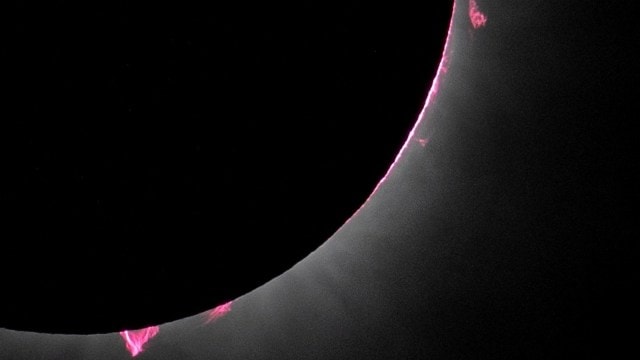Watch | How the total solar eclipse looked from space
The next total solar eclipse that will be visible in India will happen on March 20, 2034.
 Solar prominences are seen during a total solar eclipse in Dallas, Texas, U.S., April 8, 2024. (Photo: Reuters via NASA)
Solar prominences are seen during a total solar eclipse in Dallas, Texas, U.S., April 8, 2024. (Photo: Reuters via NASA)A total solar eclipse, which is a once-in-a-lifetime celestial event for most people, occurred Monday night. The eclipse began at 9.13 pm IST on Monday, April 8 and continued till 2.22 am IST on Tuesday, April 9.
The totality of the eclipse was visible to parts of the world under the Moon’s umbra, the darkest part of its shadow.
A total solar eclipse was only visible in parts of the United States, Mexico and Canada. A partial eclipse was visible in parts of some Caribbean countries, Colombia, Venezuela, Spain, the United Kingdom, Ireland, Portugal, and Iceland.
Visuals of the total solar eclipse:
Astronauts on board the International Space Station were able to see two views of the eclipse – moon passing in front of the sun, and the shadow of the moon passing over Earth. Here are visuals shared by the National Aeronautics and Space Administration (NASA) over social media:
Ever seen a total solar #eclipse from space?
Here is our astronauts’ view from the @Space_Station pic.twitter.com/2VrZ3Y1Fqz
— NASA (@NASA) April 8, 2024
NASA also shared a video of the total solar eclipse sweeping through Indianapolis. According to the space agency, this was the first time in more than 800 years that the city experienced this celestial event.
The total solar #eclipse is now sweeping across Indianapolis.
This is the first time in more than 800 years that the city is experiencing this celestial event! pic.twitter.com/jZuKx4nUAb
— NASA (@NASA) April 8, 2024
Here’s a replay of the moon’s shadow passing across the path of totality, as seen by NOAA’s GOESEast satellite:
Watch a replay of the moon’s shadow traveling across the path of totality, seen from @NOAA’s #GOESEast satellite.#TotalEclipse #Eclipse #Eclipse2024, #TotalEclipse2024 #NOAATotalEclipse2024, #2024Eclipse pic.twitter.com/eNaRb6qoKH
— NOAA Satellites (@NOAASatellites) April 8, 2024
Satellite internet constellation, Starlink, also posted a video of the orbit during the eclipse from one of its satellite.
View of the solar eclipse from a Starlink satellite on orbit pic.twitter.com/RAwT2uQUUh
— Starlink (@Starlink) April 8, 2024
NASA had estimated that 31.6 million people live in the path of totality this year compared to just 12 million in 2017. On top of that, another 150 million people live within a 321-kilometre radius of the path of totality.
The next total solar eclipse that will be visible in India will happen on March 20, 2034.







